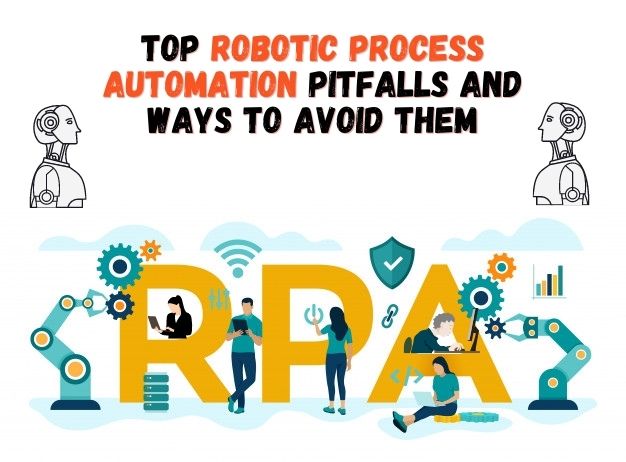Before integrating RPA in an organization one must know about the problems. Pitfalls that might arise with RPA pitfalls from the initial stage. We must channelize and often take responsibility of the odds which might favor us from the endeavors and then we should not permit ourselves to get indulged in weird expectations. The failure of the project has a long list of reasons behind it. We are representing to you, the 7 Ways To Avoid Robotic Process Automation Pitfalls. So let us dive a little deeper into the potentiality of the RPA pitfalls and the consequent means to keep it away while integrating RPA.
Predicting the future becomes a very important aspect for all the good results and successful implementation of RPA. Knowing the reasons behind the software robots during its integration whether something is wrong or not is the main task that should be executed by the team who is eagerly integrating such bots in the organization.
Know These 7 Ways to Avoid Robotic Process Automation Pitfalls
Here, the complete list of the 7 factors which are to be taken into consideration which is to be avoided if the organization needs to be protected from RPA pitfalls:
1.Not choosing the right processes to automate in the beginning
This also refers to picking up the correct. The most appropriate procedure for all the making an effective start off making the utilization of automation in the business. Avoiding a practical evaluation that is complete, exhaustive, and which is completely relatable and that might get passed on to all the robots.
Starting something which is completely wrong will definitely result in inefficient management of all the workflows.
The business impacts and the complexity of the projects must be performed which has a cost-benefit analysis of automating the complete process of candidates and it is completely dependent on what needs to be considered in the top goals.
2.Trying to automate the RPA on its own
RPA smoothens up the technical ways which can conduct the operations at a faster and smoother rate in an efficient manner all the tedious and repetitive work which would ultimately cause the employees unnecessary distress, fatigue, and even boredom.
The high technicality of RPA makes it unadvisable that you need to attempt and carry out the complete process of implementation on its own. The complete division of labor remains with all of us for a good reason and you need to forget while delegating the responsibilities of its implementations to all the experts of RPA and who can handle it without making any tedious efforts.
3.Not setting up the clear objectives for the automation of strategies
It is the basic thumb rule: It becomes pivotal that the business objectives. Even the role which gets played with RPA in maintaining the operations there is defined clearly.
Where exactly will you deploy RPA?
There are many uncertainties in such respects that are likely to put burdensome on such things and the complete answers to these questions will further enhance the smooth transition by delegating the tedious, repetitive tasks which are time-consuming and which must be free from human errors.
4.Not having a Birds Eye View over the complete implementation process
Integration of RPA is a complex enterprise. It comes as nothing to surprise me but for all the activities which are meant to take some deep effect on the business. So to achieve the goals one needs to make sure that the proper executive control is to be considered. This procedure requires the complete team which can simply make a watch over the complete process.
Some of them often label it as an operational insight while others called it as governance of accretion and simply governance while other keeps on emphasizing that how important it is to include the responsible team which is not domain-specific but it also has some people who can take the complete control of playing an executive role of the central processing unit.
In the long run, this needs to take the complete form of the RPA center of excellence which permits the strategic management of the overall system.
5.Not ensuring the scalability potential of software robots
Scalability is one of the hidden gems which is certainly not responsible for the complete scale of adoption of RPA.
It completely means that you really should not permit anything which stands in the complete way of all the scalable bots which can ensure consistency and even across the board use of RPA in all the individual departments of the business.
6.Relying solely on the IT department
You would not prefer that all the smooth and speedy functions of RPA. RPA’s conditioning that to the IT department is not your cup of tea. IT assistance is pivotal for automation but the idea is that one should not overdo it. The bottom line is something along the lines of the phrase which is rendered into the IT things which are completely IT-related and automation codes and into the departments where the automation wave is better dealt with by all other departments.
7.Not testing the software robots thoroughly
Haste makes waste is something which can be considered as true and one must admit it. Since then you would not like to waste effort, time & money. Even hope which you get invest in RPA and one should not get into the slip by the threshold.
As for testing the processes of production one needs to test the processes priorly to making sure that it is like behavior between Development and the production team. This incorporates and ensures the apps of the same version, testing the apps under normal and all the peak loads throughout the day, servers and apps on the server farm all behave identically, etc.
The Last Lines of 7 ways to Avoid Robotic Process Automation pitfalls
We all believe that you are now getting better prepared to inaugurate the successful RPA journey. The failure of the anticipation is just not meant to alarm you. Rather than motivating it to have a realistic view over what might happen so that you can be preventive and watch for pitfalls. Here, we discussed the top 7 ways to avoid Robotic Process Automation pitfalls in this article.
Anticipation and planning pro-actively must take you a step closer to all the glorious passing finish lines. Integrating RPA can be a successful scheme for both timeliness and cost-effectiveness.
Such an extensive and deep understanding might lead the organization to make the use of best practices for integrating RPA and same will be found in Salesforce Automation Software
Selecting the process wisely, a plain understanding of all human resources or reliance. RPA sponsors are some of the practices which are of high value.
About the Author
Parth Patel is a serial entrepreneur and CEO of SyS Creations which is a top provider of RPA in Healthcare. Operating the IT Infrastructure of SMEs, startups keeps them on his toes and his passion for helping others keeps him motivated.




